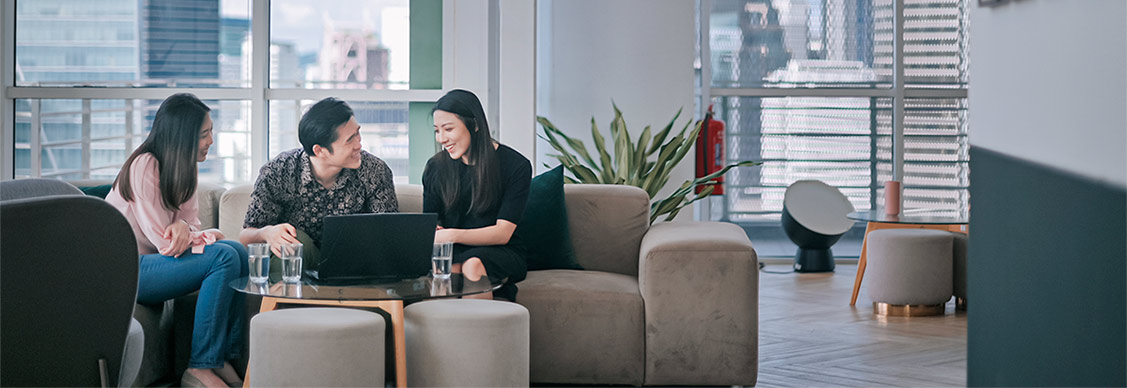Corporate challenge: Making offices better amid budget cuts
Environmental goals and the talent war have companies looking for cost-effective improvements
With budget cuts on the horizon, companies trying to lure people back to the office are having to balance sustainability goals and hip amenities with the need to save money.
As it turns out, they’re finding that it’s not an either-or decision.
Excesses of the past, like premium office chairs that cost up to US$20,000, are getting the cut.
But other areas that might have longer-term value, such as sustainability, are seeing increasing investment. In a recent survey in Asia Pacific, companies said they are planning to prioritize spending on offices when it helps achieve a high sustainability rating.
“Companies now realize that they must be environmentally conscious and look after their employee wellbeing, while being more frugal and more socially responsible,” says Martin Hinge, Head of Project and Development Services, Asia Pacific, JLL.
The new priorities mark a departure from last year’s survey, where companies said they would increase spending on technology solutions that allowed for better experiences for hybrid workforces.
Reducing environmental impact
In the face of budget cuts, companies remain committed to investing in sustainable materials that lower the carbon footprint of the office, according to the JLL survey.
“The type of materials chosen in an office design extends beyond aesthetics and ties back to sustainability,” says Hinge. “Adopting a circular design minimizes materials, prioritizes reuse and refurbishment with new products only when necessary.”
For instance, worktops installed in JLL’s Water Street office in London are constructed using 100% recyclable post-industrial plastic waste while acoustic wall coverings are made from 60% recycled leather waste and other natural materials.
“Using a mix of natural, recyclable, and sustainable materials not only constitutes a lower carbon footprint, but also helps create a comfortable workplace environment for employees,” says Hinge.
But not all companies are on the same page regarding office improvements such as expansion or reconfiguration of space — most of which will likely only be implemented on a smaller scale this year, Hinge says.
“A lot of companies are still grappling with what this means for their office,” says Hinge. “Those who haven’t yet committed to changes may indirectly pay the consequences later on.”
Getting green-certified
Achieving sustainability ratings has also emerged as a priority for office improvement in a wider drive toward sustainable design.
More than 40% of Grade A office buildings in Asia are already green-certified, JLL data shows. Common sustainability certifications include LEED for green buildings and WELL, which measures how a building promotes health and wellness for its occupants.
Acquiring such certifications is becoming a norm as younger employees expect their employers to follow sustainable business practices, but it is still only the first step in a long journey.
“For an office to become net zero carbon, you need to ensure the building is first fully electrified without using other energy sources like gas or coal-fired district heating,” says Hinge. “The next phase would be to wean the building off the coal-powered grid and draw energy from renewable sources before switching out all plant and equipment to electric-only and low-energy.”
As more companies embed green commitments into design, spending on sustainability elements such as low-energy appliances, efficient lighting systems, and occupancy sensors, has likewise grown steadily across Asia Pacific, according to JLL’s Fit-Out Cost Guide.
Improving office amenities
Besides environmental sustainability, companies are also looking into transforming the office into a compelling destination for employees.
For companies, this may mean investing in new amenities or retrofitting and reconfiguring the office — starting with a redesign of common areas which have yet to evolve much beyond a cafeteria, according to Hinge.
“Many employees want to work in a quasi-domestic environment that they get at home when they’re in the office with their colleagues,” says Hinge. “It could be designed as a flexible multi-purpose space within a club or hotel environment, packed with amenities and offering a high level of service and convenience.”
A majority of corporate real estate leaders already recognize that workplace design is instrumental in enhancing employee engagement and wellbeing, according to JLL’s Future of Work Survey.
However, the extent of spending on office fit-out improvements would depend on how badly markets are weighed down by budgetary constraints, Hinge says.
“The majority of office fit-out spend in Asia Pacific is on hold at the moment as companies grapple with inflation and figure out how to attract staff back to the office,” says Hinge.
“But we expect this to change in the second half of 2023 as interest rates in the US plateau, and corporations look to meet pent-up demand.”
